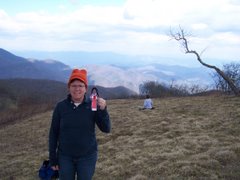Post by Bob Ryder, Germantown, Maryland
 The summer training in West Virginia was approaching and my excitement was building. I had high expectations and knew the experience would be awesome. I drove only one hour from my home in Maryland. So, I thought about all the great people I would meet and the useful information I would receive.
The summer training in West Virginia was approaching and my excitement was building. I had high expectations and knew the experience would be awesome. I drove only one hour from my home in Maryland. So, I thought about all the great people I would meet and the useful information I would receive.
I arrived at the National Conservation Training Center and was instantly impressed with the facility. I was greeted by the staff at the welcome center and truly felt like a guest at a fine resort.
After getting settled, we all gathered to meet our classmates for the week. It was great to meet so many educators who are inspired and eager to incorporate the Appalachian Trail awareness into the classroom. As I mingled with all of the folks from the TTEC group, we all became comfortable and excited for the program, to begin.
I woke up on Monday morning feeling well rested and eager to get the day started. I headed to the cafeteria to grab some breakfast. The dining this week was fantastic. Every meal was great and the food selection was very good.
We then all met at the classroom and started our morning with introductions and some ice breakers. It was fun and exciting to meet everyone and learn about who they were and where they were from. There were a variety of educators from Georgia to Maine. Teachers of different grade levels ranging from Kindergarten all the way up to a college professor. The schools that these teachers come from also had a wide spectrum of school demographics. Our cohort included schools from very rural areas with predominantly Caucasian students and urban schools that included populations that had African American and Hispanic students.
We all had a chance to introduce ourselves and review our backgrounds and experiences with the Trail. I learned that there were a few teachers that had never visited the Appalachian Trail. I felt a little bit more comfortable because my school is located about 40 miles from the A.T. and almost none of my students have ever heard of the A.T. let alone, ever visited the A.T.
The week was jam packed with tons of great presentations. Just to name a few...
Journal writing, Geo-caching, Quests, Backpacking, Orienteering, Project Wild, Poetry, History of the A.T.
One of my favorite activities was Backpacking on the A.T. and staying overnight on the trail. Although we only hiked a few miles, it was a great experience and I felt pretty tired. It was an eye-opening experience. I learned that backpacking is NOT the same as camping. Camping is when you can pack your car with as much stuff as you want and just pull up to your campsite and relax. Backpacking is much more physically demanding. I know now that you pack only the necessities and have to remember to keep your pack lite.
After hiking a few miles, I learned that I had packed too many unnecessary items and my pack was very heavy.
Well, after an amazing week filled with great presentations and meeting great people, I was tired yet also excited to bring all the useful tools and ideas back to my school. I felt well equipped and very informed about how the A.T. can be integrated into any school’s curriculum.
Now, it’s time to put it all into action!
 Dr. Tom (named that because he’s from Georgia) Howick taught the session this summer focused on using Nature Notebooks. I have used this idea with my class this year and have been pleased with them for several reasons. First, they look cool. We painted the covers by doing the leaf printing that was done during our night gathering in West Virginia (before Zack and Bob starting singing “Dirty Quarters”). We gathered sticks and bound pages together, giving them the natural look, only we don’t have any beaver sticks like Tom’s notebook. The second reason I like the Nature Notebooks is it sets the tone for our outside classroom.
Dr. Tom (named that because he’s from Georgia) Howick taught the session this summer focused on using Nature Notebooks. I have used this idea with my class this year and have been pleased with them for several reasons. First, they look cool. We painted the covers by doing the leaf printing that was done during our night gathering in West Virginia (before Zack and Bob starting singing “Dirty Quarters”). We gathered sticks and bound pages together, giving them the natural look, only we don’t have any beaver sticks like Tom’s notebook. The second reason I like the Nature Notebooks is it sets the tone for our outside classroom. 
















